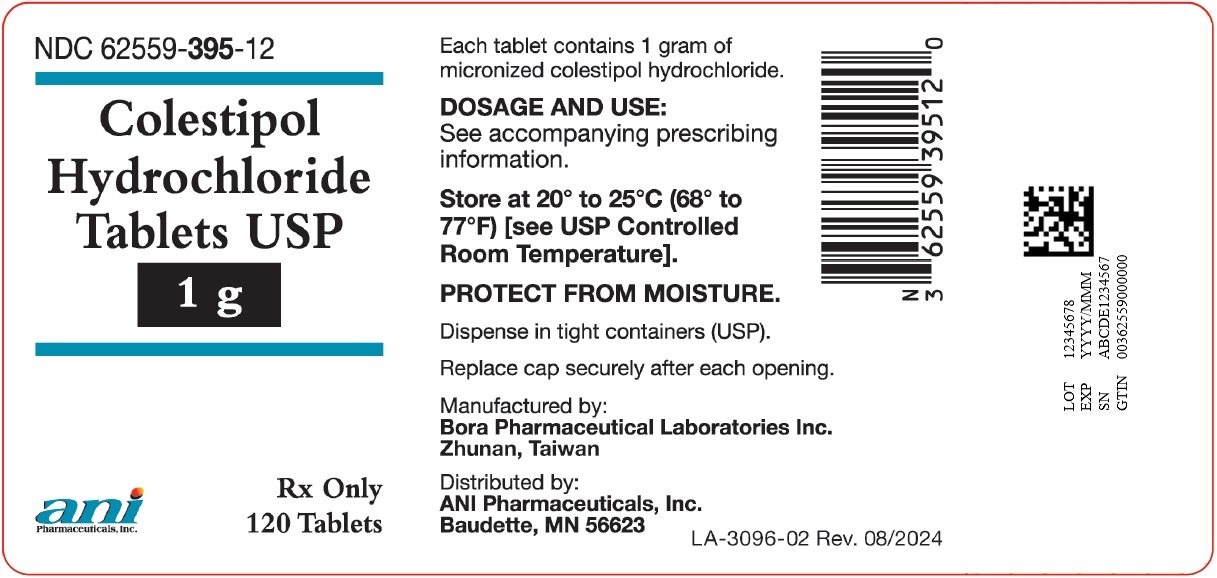COLESTIPOL HYDROCHLORIDE
Colestipol Hydrochloride Tablets USP
3d380b5e-e346-4a47-ac95-faa37c6f2a51
HUMAN PRESCRIPTION DRUG LABEL
Sep 12, 2025
ANI Pharmaceuticals, Inc.
DUNS: 145588013
Products 1
Detailed information about drug products covered under this FDA approval, including NDC codes, dosage forms, ingredients, and administration routes.
COLESTIPOL HYDROCHLORIDE
Product Details
FDA regulatory identification and product classification information
FDA Identifiers
Product Classification
Product Specifications
INGREDIENTS (9)
Drug Labeling Information
PACKAGE LABEL.PRINCIPAL DISPLAY PANEL
PACKAGE/LABEL PRINCIPAL DISPLAY PANEL
NDC 62559-395-12
Colestipol Hydrochloride Tablets USP, 1 g
Rx Only
120 Tablets

ADVERSE REACTIONS SECTION
ADVERSE REACTIONS
Gastrointestinal
The most common adverse reactions are confined to the gastrointestinal tract. To achieve minimal GI disturbance with an optimal LDL-C lowering effect, a gradual increase of dosage starting with 2 grams, once or twice daily is recommended. Constipation is the major single complaint and at times is severe. Most instances of constipation are mild, transient, and controlled with standard treatment. Increased fluid intake and inclusion of additional dietary fiber should be the first step; a stool softener may be added if needed. Some patients require decreased dosage or discontinuation of therapy. Hemorrhoids may be aggravated.
Other, less frequent gastrointestinal complaints consist of abdominal discomfort (abdominal pain and cramping), intestinal gas (bloating and flatulence), indigestion and heartburn, diarrhea and loose stools, and nausea and vomiting. Bleeding hemorrhoids and blood in the stool have been infrequently reported. Peptic ulceration, cholecystitis, and cholelithiasis have been rarely reported in patients receiving colestipol hydrochloride granules, and are not necessarily drug related.
Difficulty swallowing and transient esophageal obstruction have been rarely reported in patients taking colestipol hydrochloride tablets.
Transient and modest elevations of aspartate aminotransferase (AST, SGOT), alanine aminotransferase (ALT, SGPT) and alkaline phosphatase were observed on one or more occasions in various patients treated with colestipol hydrochloride.
The following nongastrointestinal adverse reactions have been reported with generally equal frequency in patients receiving colestipol hydrochloride tablets, colestipol granules, or placebo in clinical studies:
Cardiovascular
Chest pain, angina, and tachycardia have been infrequently reported.
Hypersensitivity
Rash has been infrequently reported. Urticaria and dermatitis have been rarely noted in patients receiving colestipol hydrochloride granules.
Musculoskeletal
Musculoskeletal pain, aches and pains in the extremities, joint pain and arthritis, and backache have been reported.
Neurologic
Headache, migraine headache, and sinus headache have been reported. Other infrequently reported complaints include dizziness, light-headedness, and insomnia.
Miscellaneous
Anorexia, fatigue, weakness, shortness of breath, and swelling of the hands or feet, have been infrequently reported.
To report SUSPECTED ADVERSE REACTIONS, contact ANI Pharmaceuticals, Inc. at 1-855-204-1431 or FDA at 1-800-FDA-1088 or www.fda.gov/medwatch.
REFERENCES SECTION
REFERENCES
Summary of the Second Report of the National Cholesterol Education Program (NCEP) Expert Panel on Detection, Evaluation, and Treatment of High Blood Cholesterol in Adults (Adult Treatment Panel II). JAMA 1993; 269(23):3015–3023.
Lipid Metabolism-Atherogenesis Branch, National Heart, Lung, and Blood Institute, Bethesda, MD: The Lipid Research Clinics Coronary Primary Prevention Trial Results. I. Reduction in Incidence of Coronary Heart Disease. JAMA 1984; 251:351–364.
Parra HJ, et al. Differential electroimmunoassay of human LpA-I lipoprotein particles on ready-to-use plates. Clin. Chem. 1990; 36(8):1431–1435.
Barbaras R, et al. Cholesterol efflux from cultured adipose cells is mediated by LpAI particles but not by LpAI:AII particles. Biochem. Biophys. Res. Comm. 1987; 142(1):63–69.
Kane JP, et al. Normalization of low-density-lipoprotein levels in heterozygous familial hypercholesterolemia with a combined drug regimen. N Engl. J. Med. 1981; 304:251–258.
Illingworth DR, et al. Colestipol plus nicotinic acid in treatment of heterozygous familial hypercholesterolemia. Lancet 1981; 1:296–298.
Kuo PT, et al. Familial type II hyperlipoproteinemia with coronary heart disease: Effect of diet-colestipol-nicotinic acid treatment. Chest 1981; 79:286–291.
Blankenhorn DH, et al. Beneficial Effects of Combined Colestipol-Niacin Therapy on Coronary Atherosclerosis and Coronary Venous Bypass Grafts. JAMA 1987; 257(23):3233– 3240.
Cashin-Hemphill L, et al. Beneficial Effects of Colestipol-Niacin on Coronary Atherosclerosis: A 4-Year Follow-up. JAMA 1990; 264:3013–3017.
Brown G. et al. Regression of Coronary Artery Disease as a Result of Intensive Lipid-Lowering Therapy in Men with High Levels of Apolipoprotein B. N. Engl. J. Med. 1990; 323:1289–1298.
Kane JP, et al. Regression of Coronary Atherosclerosis During Treatment of Familial Hypercholesterolemia with Combined Drug Regimens. JAMA 1990; 264:3007–3012.
Rx only
Manufactured by:
Bora Pharmaceutical Laboratories Inc.
Zhunan, Taiwan
Distributed by:
ANI Pharmaceuticals, Inc.
Baudette, MN 56623

LA-3097-03
Rev. 03/2025
